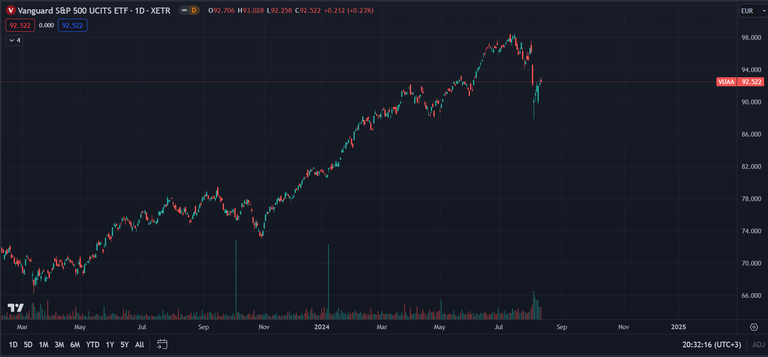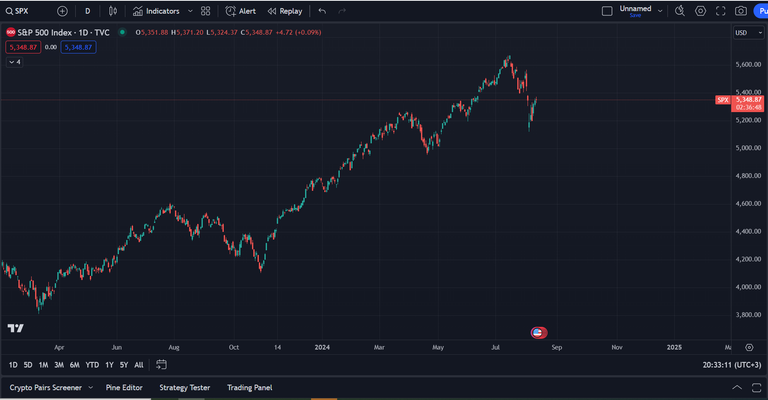At this moment, I’m actively working on diversifying my investment portfolio. Up until now, I was heavily invested in cryptocurrency. However, I’ve recently started exploring different avenues for investment. The primary reason for this shift is my belief that the most efficient way to generate wealth is to make money work for itself. While the traditional financial system may not offer the highest returns, it does provide a level of safety and predictability that’s hard to find in the crypto world. Moreover, there are numerous ways to leverage opportunities within the traditional financial framework that align with my investment goals.

To begin this diversification process, I’m considering allocating a portion of my funds into the Vanguard S&P 500 UCITS ETF (VUAA). The VUAA is a popular ETF that tracks the performance of the S&P 500, one of the most recognized indices in the world. What makes VUAA particularly appealing to me is that it automatically reinvests dividends, providing a compounding effect over time. Historically, the S&P 500 has delivered average annual returns of about 7-10% when considering both price appreciation and dividends. While past performance isn’t a guarantee of future results, the S&P 500’s consistent performance makes VUAA a potentially lucrative long-term investment. Additionally, VUAA's expense ratio is low, which means more of the returns are retained by investors rather than being eaten up by management fees.

The second strategy I’m looking into is investing in interest-bearing treasury bills. Treasury bills, often referred to as T-bills, are short-term government securities that mature in one year or less. They are considered one of the safest investments since they are backed by the government. The way T-bills work is quite straightforward: you purchase them at a discount to their face value, and when they mature, the government pays you the full face value. The difference between the purchase price and the face value is your profit. Importantly, in my country, the profits from T-bills are currently not subject to taxation, making them even more attractive. At the moment, Greek interest-bearing treasury bills offer returns of about 2.9% to 3.15% for 3- to 6-month maturities. While these returns might seem modest compared to crypto, the stability and tax advantages make them a solid option for balancing the risk in my portfolio.
The third part of my diversification plan involves utilizing a flexible bank account that offers a 4.15% interest rate for balances over 15,000 euros. One of the key advantages of this account is that it allows for easy access to my funds—I can withdraw money whenever I want. The interest is paid out twice a year, which is a nice feature for generating consistent income. However, there’s a drawback: if I withdraw any amount, say 1,000 euros, before the interest is paid, I won’t receive interest on that withdrawn amount. Despite this limitation, I consider this account a valuable tool for maintaining liquidity while still earning a respectable return.
Of course, the core of my portfolio remains in cryptocurrency, spread across various DeFi platforms that offer a range of returns. For most platforms, I’m seeing an annual percentage yield (APY) of 3% to 5%, which is comparable to some traditional investments. However, there are exceptions, like Hive, which offers up to 15% in its HBD savings. The downside to crypto, though, is the lack of liquidity, high slippage, and the complexities of dealing with taxes. In my country, capital gains from crypto are taxed at rates ranging from 15% to 50%, depending on the total income. Furthermore, using crypto exchange cards for everyday expenses can be complicated. Once you reach a certain spending threshold, these platforms might start asking for proof of funds, tax information, and more, which I prefer to avoid.
Interestingly, during bull markets, there’s often increased demand for buying crypto directly, bypassing banks and cards, which is where I conduct a significant portion of my business. However, as mentioned earlier, liquidity is a persistent issue, and managing it effectively is critical to my overall strategy.
While I’m still deeply invested in the crypto it is time to start searching some of the more traditional investing products because diversification is key to the long run.
Do any of you have any suggestion about a more traditional investing plan??
Posted Using InLeo Alpha

